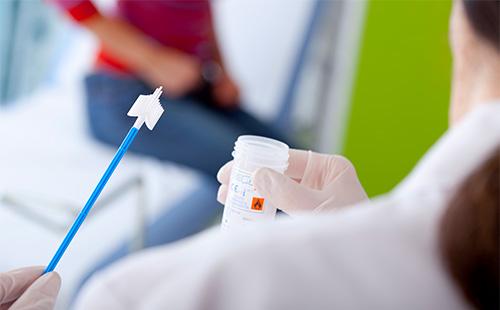The content of the article
- 1 What is this disease and why is it dangerous?
- 2 How does it appear
- 3 Can I notice the symptoms
- 4 How to identify and confirm
- 5 Tactics of women with this pathology
- 6 Treatment options
- 7 Pregnancy and childbirth with cervical dysplasia
- 8 Is it possible to avoid the disease
- 9 Reviews: “For me, the PDT method with organ preservation turned out to be salvation”
This disease is included in the international classification of diseases from the 2010 revision (ICD-10) under the code N87. In Western European literature, the term cervical intraepithelial neoplasia can often be found (according to the abbreviation of the English term - CIN or Russian CIN). Today it is one of the urgent gynecological problems among young women. In 90% of cases, dysplasia is associated with genital infections.
What is this disease and why is it dangerous?
With intraepithelial neoplasia, only the outer layers of tissues undergo changes. With CIN, cells acquire an atypical structure and subsequently easily degenerate into cancer. Depending on the severity of the changes, CIN1, CIN2 and CIN3 are distinguished, which corresponds to mild, moderate and severe dysplasia. After CIN3, changes are classified as in situ cancer - local, not common.
A neoplasm is not formed instantly. In order for cervical cancer to appear, it takes up to 10-15 years from the moment of minimal clinical changes. Therefore, it is so important to capture exactly the period when the pathology is still reversible or altered tissues can be completely removed. Statistics indicate the following:
- mild dysplasia - only in 1-3% of cases malignant; even without treatment, in 90% of cases it passes (if there is no concomitant infection), but in 10% of cases it transforms into moderate and then into severe;
- severe dysplasia - 15-20% of patients end with cervical cancer.
Dysplasia does not appear in the "empty" place. In 95% of cases, it is associated with sexual infections, especially of a viral nature - herpes, papillomas. Therefore, any treatment for dysplasia begins with a screening for sexually transmitted infections (STIs) and genital tract sanitation. With CIN1, this is often enough to make all changes go away.
Features
Cervical intraepithelial neoplasia has the following characteristics:
- develops in women of all ages;
- often occurs against a background of genital infections;
- affects only the cervix;
- begins to form in the transformation zone;
- in the absence of therapy, in 40% of cases it is transformed into cervical cancer;
- 75% require surgical treatment (excision of sites);
- after radical treatment, the woman is registered for about two years.
How does it appear
The reason for the development of mild cervical dysplasia is associated with viral damage, a special role is played by human papillomavirus (HPV). In almost all women with cervical cancer, this pathogen is retrospectively detected. However, not all carriers become ill, so the role of the virus is great, but in addition to HPV, there are other, not yet specified factors.
The role of the papilloma virus
With the onset of active sexual life and up to 30 years, 95% of girls meet with HPV. It is transmitted sexually and even by contact (for example, through personal hygiene items, non-sterile instruments). But in the majority, immunity gives a good answer, and the pathogen, having spent some time in the cells, eliminates without a trace. In such cases, a woman will never remember that she had an HPV infection, since she is asymptomatic. In the rest of the cases, the virus enters the cells of the cervix and then integrates into their genetic material.
It turns out that for the body, HPV is “invisible”, but the cell functions differently and subsequently its probability of cancerous degeneration is high. At the same time, the “smart virus” sets up the cell to reproduce a large number of HPV, which then also infect other tissues and “hide” from the body’s immunity. The number of HPV copies is growing exponentially. The virus stimulates the formation in the body of a woman of one of the varieties of estrogen, which potentiates the synthesis of new pathogens.
There are a huge number of strains human papillomavirus. The most dangerous and oncogenic for the genitals are 16, 18, as well as 31, 33, 35, 39, 45, 51, 52, 54, 56, 66, and 68. Others cause the following changes:
- genital warts;
- plantar papillomas;
- common warts;
- papillomas of the larynx;
- changes in the epithelium of the skin and mucous membranes without overgrowth.
Risk groups
Undoubtedly, there are mechanisms that have not yet been established. Long-term clinical observations allow us to identify the risk group of women for the development of intraepithelial neoplasia and the high risk of its further malignant degeneration.
- Smokers. The combustion products of cigarettes and nicotine penetrate the blood of a woman and are carried throughout the body, they are also found in cervical secretions. Here they negatively affect the cells of the cervix. In addition, smokers have reduced immunity against HPV.
- Multiparous. Women who have had three or more births are also at risk for cancer. It is believed that this is due to a decrease in immunity during the bearing and activation of the virus at this time.
- With early experience. The sooner a girl begins sexual activity, the more partners she has and the likelihood of getting some kind of sexual infections.
- With an STI. Chlamydia, ureaplasmas, trichomonads, mycoplasmas, gonococci, herpes simplex virus help HPV invade epithelial cells and multiply actively there. In addition, all these pathogens on their own can cause dysplastic changes, most often mild and treatable.
- Born early. It is noted that among girls who gave birth to 16 years old, the incidence of cervical cancer is also increased. There is no definite explanation for this.
The following factors are also important.
- Heredity. In the presence of cervical cancer in close relatives, the likelihood of getting sick increases by two to three times. Also, the risk is increased in those families where there is a general predisposition to cancer of any location.
- Contraception. During such contraception, the woman's hormonal background changes.Pregnant-protected girls are more active in sexual contact. All this increases the risks of malignancy.
- Diethylstilbestrol. In the middle of the XIX century, this drug was prescribed for pregnant women with problematic bearing. Today, the long-term consequences of such treatment are studied - girls who were born from those mothers are susceptible to the development of one of the forms of cervical cancer - adenocarcinoma.
- Immunodeficiency. This can be against the background of HIV, hepatitis and diseases of the immune system. However, the body cannot adequately respond to the introduction of HPV.
Can I notice the symptoms
All the insidiousness of the disease lies in the fact that the symptoms of cervical dysplasia of the 1st degree, 2 or 3 are practically absent, including ultrasound. A woman can only be bothered by the following:
- various discharge;
- pathological smell on linen or from the vagina;
- spotting after sex.
How to identify and confirm
Signs of cervical cell dysplasia can be detected in the following examinations.
Oncocytology smears
On the territory of Russia and the former Soviet Union, material is sampled using a conventional smear with a cytobrush (Eyre spatula, cotton swab) from the surface of the neck and from the cervical canal. After that, the doctor applies the resulting tissue to a glass slide, which is subsequently sent for research to the laboratory.
Fluid cytology
In this case, tissue is taken (also possible with a cytobrush) from the surface of the cervix and cervical canal, all material is placed in a special environment and then sent to the laboratory. After which the cytologist performs cell sampling, he can repeat this several times if necessary or in case of doubt. An important advantage of liquid cytology is that immediately (without a second visit) when revealing a pathology, you can conduct an additional study, for example, to detect HPV.
Biopsy
It is carried out in the presence of visible altered areas or a suspicious picture by colposcopy. After taking the material (excision with an ordinary scalpel, loop, nippers), the tissues are sent for histological examination. After staining and examination under a microscope, the doctor may indicate the degree of cervical dysplasia.

Cervical canal scraping
May be performed on an outpatient basis. But more often it is carried out along with curettage of the uterine cavity or in the process of hysteroscopy. The advantages of scraping are that after the expansion of the cervical canal, it is free to obtain material from the entire depth of the neck, and not just its surface. Therefore, the method is preferable for women after 45 years, when the transformation zone moves in depth.
Colposcopy
This is one of the modern types of diagnosis of cervical diseases.But the informational content of colposcopy does not exceed 40-60%, so it matters only as an auxiliary method.
The essence of the study is to stain the cervical epithelium with various solutions (for example, iodine) and then examine it under a microscope. The resulting image can indirectly judge pathology.
Tactics of women with this pathology
When identifying or suspecting dysplasia, the algorithm of actions of the doctor and woman is as follows:
- full STI screening - identifying an infection by analysis helps to speed up recovery and minimize traumatic interventions;
- if 1 degree of cervical dysplasia is detected - You can limit yourself to non-surgical treatment and observation;
- if cervical dysplasia of the 2nd degree is revealed- at the age of women up to 35, you can start with drug treatment, after - a detailed examination, and only then treatment;
- if cervical dysplasia of the 3rd degree is revealed - examination and subsequent therapy are performed.
A comprehensive examination for dysplasia includes repeated smears for cytology (if there was a liquid cytology, it is not necessary), separate diagnostic curettage of the uterine cavity and cervical canal (RVD), cervical biopsy from suspicious places according to the results of colposcopy. With the re-detection of dysplasia, instead of RDV, it is better to perform hysteroscopy.
When CIN2 is detected, the doctor's task is to ensure that there are no pronounced changes and cancer. Treatment of mild to moderate cervical dysplasia may be limited to conservative means. With CIN3, one of the lesion removal operations is performed. After the treatment, the woman is registered for another two years. At this time, it is necessary to visit the doctor more often and take control smears for cytology (or its liquid variant). With CIN1 - inspections every six months, with CIN 2 and 3 - the first year every three months, then another year - every six months. This is necessary to control the recurrence or progression of the pathology.
Treatment options
Whether cervical dysplasia is dangerous is determined based on the results of the examination. In relapse or in women after 35-40 years old, surgical methods are preferred, especially with CIN 2 and 3. Treatment is always carried out according to an individual plan. After the end of the course, smear control is carried out, if necessary - scraping from the cervical canal or RDV.

Conservative
First of all, thorough rehabilitation of the genital tract is carried out, especially when identifying STIs. Both local therapy (candles, baths, douching, vaginal tablets) and systemic treatment (oral medication) are used. The following groups of drugs are prescribed.
- Antibiotics. Most often it is a penicillin group (Ampicillin, Amoxicillin), macrolides ("Azithromycin"," Erythromycin "," Josamycin "," Clarithmicin "), tetracyclines ("Doxycycline"). The appointment of antibiotics is ideal taking into account PCR examination or sowing of vaginal and cervical contents.
- Antiviral drugs. Used for suspected viral damage according to the results of smears for cytology, biopsies or scrapings from the cervical canal. Applies "Acyclovir"For herpetic infection, as well as drugs from the group of interferons or stimulators of their production ("Geneferon"," Ruferon "," Cycloferon ").
- Immunomodulators. They are used as an addition to antibacterial and especially antiviral treatment. Effective drugs such as Likopid, Groprinosin.
- Antiseptic drugs. Most often these are candles with iodine "Povidone iodine", "Ruvidon", as well as "Hexicon».
- Estrogenic drugs. Used only when there are small foci of dysplasia in menopause on the background of atrophic processes.
Surgical
The most suitable for the treatment of dysplasia is the radio wave method and surgical conization. The main advantages of the methods are as follows:
- provide good healing;
- you can adjust the depth of tissue removal;
- the resected material is sent for histological examination;
- healthy tissue is not damaged.
The last point is most important, since you can thoroughly determine whether there are signs of a malignant lesion in the material and the exact stage of dysplasia. When identifying areas with different severity of the process, further treatment and observation is based on more pronounced changes.
If changes are detected at the border of the resected tissues, conization can be repeated, but more broadly. Sometimes preference is given to amputation of the cervix - removal of its part. For example, if dysplasia is combined with gross cicatricial changes in the neck after childbirth.
In some cases, the following surgical methods are used.
Laser treatment
Under the influence of a laser, tissue “evaporates”. So you can remove the surface foci, but those located in the depths cannot be reached. The disadvantage of the procedure is that after treatment there is no tissue left that could be sent for histological examination.
- Diathermocoagulation. This is cauterization of cervical dysplasia with electric shock. It can be used only for superficial changes. For example, when mild dysplasia is combined withcervical erosion. But diathermocoagulation (DEC) is the most time-consuming healing method of treatment, it is rarely used.
- Cryodestruction. Under the influence of liquid nitrogen, tissue “freezes”. Over time, a scar forms and the renewal of damaged areas. In the treatment of dysplasia, it is also rarely used, since tissues after cryodestruction are destroyed and there is no way to study them histologically. Also, when exposed to liquid nitrogen, it is difficult to control the depth of exposure.
One of the options for modern treatment is photodynamic therapy. In this case, a certain substance is applied to the affected area, in this case, a gel on the cervix. It penetrates into cells and changes the sensitivity of pathological tissues to the effects of laser beams. Subsequently, several sessions of such exposure are performed, which leads to the removal of dysplasia. The gel is harmless to the body, quickly excreted, the procedure itself is painless and can be applied even with CIN3.
Pregnancy and childbirth with cervical dysplasia
Dysplasia is not a hindrance to conception. Moreover, sometimes pathological changes in the cervix are detected during pregnancy. A special hormonal background contributes to the progression of the disease, so during this period it is important to carefully and regularly undergo an examination in order to establish progression and treatment in time. Surgical methods are not used during gestation, as this can lead to loss of pregnancy. Whether it is possible and necessary to use medications after getting pregnant, the attending physician decides.
Childbirth with established dysplasia is carried out mainly by caesarean section to avoid negative consequences primarily for a woman (for example, bleeding, tears) and for a baby (infection with HPV or HSV in case of chronic infection).

Is it possible to avoid the disease
Prevention of dysplasia includes the following:
- the exclusion of the early onset of intimate relationships and childbirth;
- ideally - one sexual partner all my life;
- in case of random sex, protection with a condom;
- timely visit to the gynecologist and treatment of diseases;
- quitting smoking, including passive smoking.
Cervical dysplasia is a serious disease, an intermediate version of the pathology between inflammation on the cervix and cancer. A careful attitude to your health, timely and regular examination by a gynecologist, sexual literacy is the key to a woman's health. The treatment of cervical dysplasia is based on many factors (age, stage, comorbidity), it can be conservative and prompt.
Reviews: “For me, the PDT method with organ preservation turned out to be salvation”
I had dysplasia of the 2nd degree and HPV 16/18 3 years ago. went through three courses of treatment, the first immunostimulating + indinol1.5 months, then two more courses of indinol for 1.5 months. Then everything is clean, watched for a year. Now a little daughter is growing, here she’s passed her cytology again, I'm waiting for the result ...
Olga http://www.woman.ru/health/woman-health/thread/4007257/
I had a long-standing erosion. But she began to treat her when she showed up mastopathy. One of the causes of mastopathy is problems in gynecology. After passing the tests revealed dysplasia of the 1st degree. I removed it with wave therapy, after it immediately passed tests for histology, then dysplasia of the 2nd degree against the background of tsertsovit. Another wave therapy (already 2nd) Next, pierced ferrovir, candles geneferon. Again dysplasia of 2-3 degrees. Again wave therapy. She was registered with an oncologist. It took about 1.6 years. Today, I went to the oncologist for the results of the tests - and .... there is no erosion or dysplasia, they were removed from the register in oncology, observation at the place of residence.
Nata http://www.sikirina.tsi.ru/forum/ginekologicheskie-zabolevaniya/displaziya-sheyki-matki-lechenie1.html
There was a dysplasia of 2-3 degrees against the background of HPV 16. Diagnosis: cervical dysplasia of 2-3 degrees, HPV 16. Gynecologist's recommendations: conization. Alternative treatment options: Photodynamic therapy. Bottom line: PDT treatment, cytology - normal, HPV - normal. Surgical methods of treatment, namely, conization of the cervix, did not suit me, since the plans were for the birth of another child, so for me the PDT method with preserving the organ was a salvation.
cmirnovaalla7, http://forum.ykt.ru/viewmsg.jsp?id=17649226

